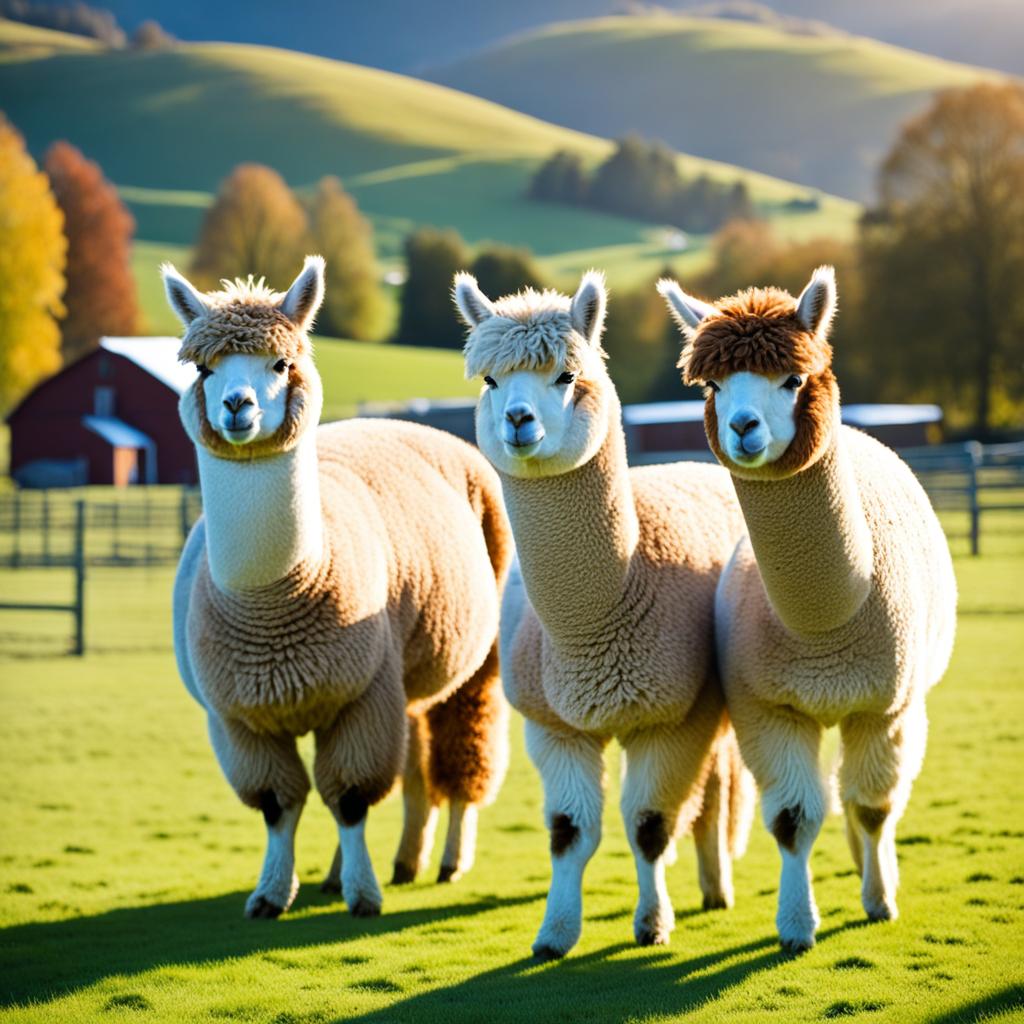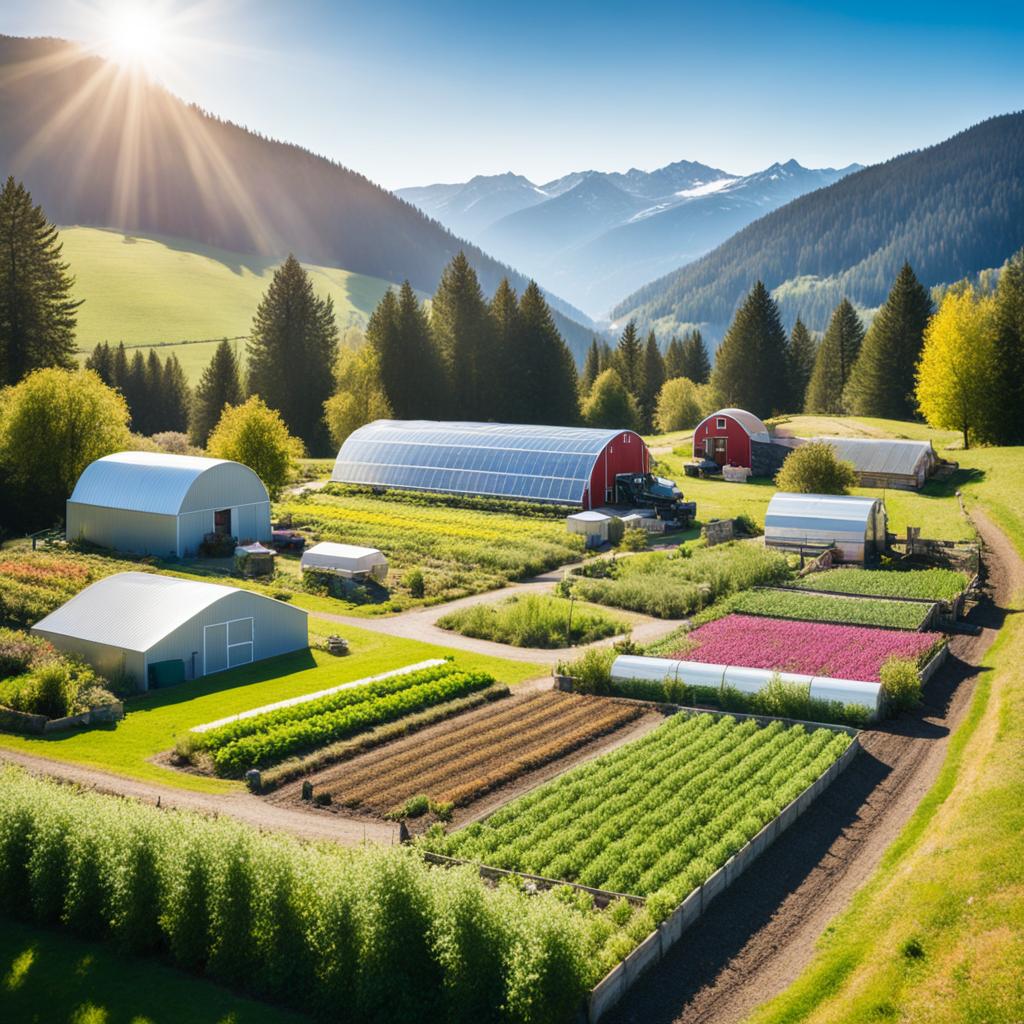Growing a small farm can be a rewarding and profitable endeavor, even for those who only have weekends to dedicate to their agricultural pursuits. With the right ideas and a little creativity, you can turn your free time into a thriving small-scale farming business.
Technology and imagination have opened up a world of opportunities for weekend farmers. Gone are the days when large plots of land and significant investment were necessary to be successful in the farming industry. Today, small farms can profit from unique and less traditional farming ideas that require minimal space and resources.
From beekeeping and microgreens to hops and beyond, there are endless possibilities to explore for those looking to embark on a weekend farming venture. So, if you have a passion for the land and a desire to turn it into a profitable business, read on to discover some inspiring small farm ideas you can pursue during your weekends.
Key Takeaways:
- Weekend farmers can turn their passion into a profitable business with the right small farm ideas.
- Technology and creativity have opened up opportunities for small-scale farming with minimal resources.
- Beekeeping, microgreens, and hops are just a few examples of profitable small farm projects.
- Investing your weekends in farming can lead to a rewarding and lucrative endeavor.
- Explore these small farm hobby ideas and discover the joy of outdoor weekend farm activities.
Rural Agriculture Small Farm Ideas
As rural areas offer vast landscapes and natural resources, small-scale farming in these locations can be highly profitable. Farmers in outlying regions have unique opportunities to engage in agricultural activities that are perfectly suited for rural settings. Whether you have a small plot of land or a larger farm, there are several profitable ideas that can turn your agricultural endeavor into a successful business venture.
1. Tree Nurseries
Starting a tree nursery can be a lucrative option for rural farmers. Trees have a high market demand for landscaping, reforestation, and agriculture purposes. By researching organic tree sourcing methods, implementing sustainable practices, and considering niche markets such as selling Christmas trees or offering an adopt-a-tree program, you can maximize profitability in this sector.
2. Fish Farming
Fish farming is another profitable small farm idea that is well-suited for rural areas. It allows farmers to utilize available land and resources to raise popular fish varieties such as tilapia, cod, trout, and catfish. With an average return on investment (ROI) of 5%–10%, fish farming can provide a steady income stream for rural farmers.
3. Dual Crop Farming
Dual crop farming, also known as multiple cropping or intercropping, involves growing two or more types of crops in the same area. This method optimizes the use of equipment, soil, and water, while reducing the risk of total crop loss due to calamities, drought, pests, or diseases. Dual crop farming offers rural farmers the opportunity to diversify their agricultural output and increase their profitability.
4. Goat Farming
Goat farming is a versatile and profitable small farm idea for rural areas. Goats can provide multiple income streams, including milk, meat, fiber, and brush removal services. Goat milk and goat meat have a growing market demand, and goats can be raised on relatively small plots of land, making it accessible for rural farmers with limited acreage.
5. Alpaca Farming
Alpaca farming is a unique and profitable option for rural farmers. Alpacas are primarily raised for their high-quality wool, which has a strong market demand. Additionally, alpacas can be rented out for brush removal services or used as guard animals. Even with just one acre of land, rural farmers can establish a successful alpaca farm and tap into the niche market for alpaca products.
By embracing these rural agriculture small farm ideas, farmers in rural areas can cultivate successful and profitable businesses. Tree nurseries, fish farming, dual crop farming, goat farming, and alpaca farming offer varied opportunities for rural farmers to thrive in their agricultural pursuits and contribute to the local economy.
Tree Nursery
Starting a tree nursery can be a great investment, with the potential for high profit margins. As a small farm owner, I have found that growing trees for profit has been a rewarding and lucrative endeavor. Not only does it provide a sustainable source of income, but it also contributes to the environment by promoting reforestation and beautifying landscapes.
When considering a tree nursery, one of the key factors to success is researching organic tree sourcing methods. By focusing on organic practices, you can attract environmentally-conscious customers who prioritize sustainability. Additionally, organic trees tend to be healthier and more resilient, which can boost their market value.
Maximizing Profitability
In order to maximize profitability, it’s important to diversify your tree nursery offerings. While there is a consistent demand for various types of trees, you can also explore niche markets to increase your customer base. For example, selling Christmas trees during the holiday season can generate substantial revenue. Alternatively, starting an adopt-a-tree program where customers can sponsor and care for a specific tree until maturity can create a sense of community and generate repeat business.
I have found that by focusing on organic tree sourcing and implementing innovative marketing strategies, my tree nursery has grown from a small operation to a thriving business. The demand for quality trees continues to grow, and by staying adaptable and customer-focused, I have been able to establish a loyal customer base that drives the profitability of my small farm.
Operating a tree nursery requires careful planning, attention to detail, and a commitment to quality. It is important to nurture and care for your trees properly, ensuring they are healthy and well-maintained. By doing so, you can cultivate a reputation for providing exceptional trees, which will attract customers and drive profitability.
| Key Considerations for Tree Nursery Success | Benefits |
|---|---|
| Researching organic tree sourcing methods | – Attract environmentally-conscious customers – Healthier and more resilient trees |
| Selling Christmas trees | – Capitalize on holiday demand – Generate substantial revenue |
| Starting an adopt-a-tree program | – Create a sense of community – Generate repeat business |
Fish Farming
When it comes to profitable small-scale farming, fish farming is an excellent business idea that offers great potential. Not only does it provide a sustainable source of food, but it can also generate a significant return on investment (ROI).
“Investing in fish farming can be a smart move for farmers with available land,” says Mary Johnson, a successful fish farmer. “You don’t always need a body of water to start a fish farm, making it accessible to a wide range of farmers.”
Popular fish varieties for small-scale farms include tilapia, cod, trout, and catfish. These species are well-suited for fish farming due to their adaptability and market demand. Furthermore, fish farming offers numerous advantages, such as a shorter production cycle and higher stocking density compared to traditional agriculture.
Return on Investment (ROI)
One of the key factors that make fish farming an attractive option for small-scale farmers is the potential for a high return on investment. According to industry experts, fish farming can have an ROI ranging from 5% to 10%, depending on various factors such as market conditions, operational efficiency, and species selection.
Environmental Considerations
It’s essential to note that fish farming, like any other agricultural activity, requires careful consideration of environmental impacts. Proper waste management, water quality monitoring, and responsible feed sourcing are crucial aspects that fish farmers need to address to ensure sustainable and eco-friendly practices.
Expert Insights
“Starting a fish farm can be a rewarding and profitable venture,” says David Martinez, a fish farming consultant. “However, it’s crucial to conduct thorough research, seek guidance from experienced farmers, and comply with local regulations to maximize your chances of success.”
When starting a fish farm, it’s vital to consider factors such as location, water source, infrastructure requirements, and market demand. Seeking advice from professionals and attending workshops or training programs can provide valuable insights and help aspiring fish farmers make informed decisions.
| Fish Variety | Market Demand | Growth Rate | Profit Margin |
|---|---|---|---|
| Tilapia | High | Rapid | 15% |
| Cod | Moderate | Slow | 8% |
| Trout | High | Medium | 12% |
| Catfish | High | Fast | 10% |
Table: Comparison of popular fish varieties for small-scale fish farming
With proper planning, effective management practices, and a solid understanding of the fish farming industry, starting a fish farm can be a lucrative venture for small-scale farmers. By capitalizing on market demand and employing sustainable farming methods, fish farming offers the opportunity to combine passion with profitability.
Dual Crop Farming
Dual crop farming is a highly effective and profitable small-scale farming method that involves growing two or more types of crops in the same area. This technique, also known as multiple cropping, mixed cropping, or intercropping, offers numerous benefits for farmers.
One of the main advantages of dual crop farming is the optimal use of resources such as equipment, soil, and water. By planting different crops together, farmers can make the most efficient use of their available land. This not only maximizes productivity but also helps to conserve valuable resources, reducing waste and environmental impact.
Another key benefit is the risk mitigation that dual crop farming offers. By diversifying their crop selection, farmers can minimize the potential losses caused by calamities, drought, pests, and diseases. If one crop is affected, the other crops can still thrive, providing a buffer against total crop failure.
Dual crop farming optimizes the use of resources and minimizes the risk of total crop loss. It is a smart farming strategy that has proven to be both sustainable and profitable.
Moreover, dual crop farming can improve soil health and fertility. By growing different crops together, farmers can take advantage of complementary interactions between plants. For example, legumes can fix nitrogen in the soil, benefiting neighboring crops that require high nitrogen levels for growth. This natural symbiosis reduces the need for synthetic fertilizers and promotes a more sustainable farming system.
Furthermore, dual crop farming can enhance pest and weed control. By planting crops with different growth habits and pest vulnerabilities together, farmers can disrupt pest life cycles and create a less favorable environment for weed growth. This reduces the need for chemical pesticides and herbicides, contributing to safer and more eco-friendly farming practices.
Example of Dual Crop Farming
An excellent example of dual crop farming is the combination of corn and beans. In this traditional Native American practice known as the “Three Sisters,” corn provides a tall stalk for the beans to climb, while the beans fix nitrogen in the soil for the benefit of corn. Additionally, squash is planted around the base of the corn and beans to provide ground cover, suppress weeds, and retain soil moisture.
| Crop | Benefits |
|---|---|
| Corn | Provides support for climbing beans Shades out competing weeds Creates windbreaks |
| Beans | Fixes nitrogen in the soil for corn Enhances overall soil fertility Prevents soil erosion |
| Squash | Acts as ground cover Suppresses weed growth Conserves soil moisture |
This synergistic combination of crops demonstrates how dual crop farming can be highly efficient, sustainable, and mutually beneficial for both plants and farmers.
Goat Farming
When it comes to profitable small farm ventures, goat farming is a versatile option that offers multiple income streams. Goats can provide milk, meat, and fiber, making them a valuable asset for small-scale farmers. Additionally, goats can even be employed for brush removal services, further expanding their utility.
Goat milk products such as cheese, yogurt, and soap have witnessed a growing market demand, as they are considered healthier alternatives to cow milk products. Goat meat is also highly sought after, with its unique flavor profile appealing to a wide range of consumers. Furthermore, goat fiber, known as mohair or cashmere, is prized for its softness and warmth, making it a valuable material for the textile industry.
One of the major advantages of goat farming is that it can be conducted on relatively small plots of land. This makes it an accessible option for farmers with limited acreage. Moreover, goats are known for their ability to forage and thrive in diverse environments, reducing the need for intensive feeding regimes.
If you’re considering raising goats for profit, it’s crucial to choose the right breeds based on your intended products and market demand. Dairy goats such as Alpine, Saanen, and LaMancha are popular choices for milk production, while meat breeds like Boer and Kiko are well-suited for meat-centric operations. Angora and Cashmere goats are preferred for fiber production.
To give you an idea of the potential profitability of goat farming, let’s take a look at some figures:
| Product | Price per unit |
|---|---|
| Goat milk (1 gallon) | $15 |
| Goat meat (1 pound) | $12 |
| Mohair (1 ounce) | $6 |
| Brush removal services (per hour) | $50 |
These prices are approximate and can vary depending on your location and market conditions. However, they give you a general idea of the potential for profitability in goat farming.
If you’re interested in getting started with goat farming, it’s important to educate yourself on the specific requirements of goat care, including proper shelter, nutrition, and healthcare. Building a strong foundation of knowledge will set you up for success in this profitable small farm venture.
Alpaca Farming
When it comes to profitable small farm ventures, alpaca farming is a lucrative option that requires minimal land and resources. Unlike cattle or horse ranching, alpaca ranching is relatively easier to manage and can be done on as little as one acre of land. One of the main reasons for the popularity of alpaca farming is the high-quality wool that these animals produce, which has a strong market demand.
Alpaca wool is prized for its softness, warmth, and hypoallergenic properties. It is used to make luxury garments, accessories, and home decor items. The demand for alpaca wool products continues to grow, making alpaca farming a profitable venture for small-scale farmers.
In addition to wool production, alpacas can be rented out for other services, such as brush removal or as guard animals for other livestock. This diversification of income streams adds to the profitability of alpaca farming.
To succeed in alpaca farming, it is essential to invest in high-quality breeding stock and provide proper care and nutrition to the animals. Regular shearing, veterinary care, and adequate shelter are also important factors to consider for the well-being and productivity of the alpacas.
Overall, alpaca farming offers an exciting opportunity for small farm owners to enter the profitable world of fiber production. With its potential for high returns and relatively low maintenance requirements, alpaca farming is worth considering for those looking to maximize their profits on a small farm.

Low-capital Small Farm Ideas
Are you interested in starting a small farm but have limited capital? Don’t worry! There are plenty of low-cost small farm business ideas that can provide a steady stream of income. With some moderate investments, you can embark on a rewarding farming venture without breaking the bank. Let’s explore a few low-capital options:
1. Herb Gardening
If you have a green thumb and a passion for herbs, herb gardening can be a profitable small farm idea. High-value herbs are in demand both locally and online, making it a lucrative business opportunity. You can target local restaurants, herbalists, and essential oil makers as potential customers. The best part is that herb gardening can be started on a budget and doesn’t require a large space.
2. Bee Farming
Beekeeping is not only a fascinating hobby but also a low-cost small farm business idea. Even with a small backyard, you can start your own bee farm and reap the benefits. Honey, beeswax, bee pollen, and royal jelly are all products that can be sold for profit. Additionally, bees play a crucial role in pollination, benefiting your other crops. With minimal investment and proper care, bee farming can be a sweet way to make money.
3. Aquaponics
Aquaponics is a sustainable farming method that combines aquaculture and hydroponics. It is an efficient way to grow both fish and crops, utilizing water and land resources effectively. Aquaponics farms have a high demand in the market due to their ability to produce a variety of crops year-round. This low-capital option is perfect for those looking for a unique and profitable small farm business idea.
4. Microgreens Farming
Microgreens farming is a niche but highly profitable small farm business idea. Microgreens, which are young and tender edible plants, are in high demand in the culinary industry. They have a quick growth cycle, allowing for multiple harvests in a short amount of time. With minimal investment and a small space requirement, you can start growing microgreens and sell them to restaurants and individuals.
| Low-capital Small Farm Ideas | Description |
|---|---|
| Herb Gardening | A low-cost option that involves growing and selling high-value herbs to local businesses. |
| Bee Farming | Start your own bee farm to produce honey, beeswax, and other bee-related products for sale. |
| Aquaponics | A sustainable farming method combining fish farming and crop cultivation. |
| Microgreens Farming | Grow and sell young and tender edible plants, known as microgreens, to restaurants and individuals. |
These are just a few low-capital small farm ideas that can help you kickstart your farming venture without breaking the bank. Choose the option that aligns with your interests and resources, and watch your small farm thrive while enjoying a steady income.
Embrace your passion for farming and turn it into a profitable business, even on a budget. Start small, be resourceful, and let your dedication and hard work bring you success in the world of small-scale farming.
Herb Gardening
Herb gardening is a rewarding and profitable small farm business that allows you to tap into the growing demand for fresh, flavorful herbs. With their versatility in culinary, medicinal, and aromatic applications, herbs have become a staple in kitchens, natural remedies, and wellness practices.
To start an herb garden, you don’t need a large plot of land. Herbs can be grown in containers, raised beds, or even a small designated area in your backyard. This makes herb gardening accessible to anyone interested in small-scale farming.
When planning your herb garden, focus on cultivating a variety of herbs to cater to different tastes and preferences. Popular herbs like basil, rosemary, cilantro, thyme, and mint are always in demand. Consider including unique and specialty herbs that can command higher prices in niche markets.
One of the key advantages of herb gardening is the diverse market you can target. Local restaurants, herbalists, tea companies, and essential oil makers are potential customers who value fresh, quality herbs. Additionally, you can explore online platforms, farmer’s markets, and community-supported agriculture (CSA) programs to reach a wider audience.
It’s important to prioritize organic and sustainable practices in your herb garden. Many customers seek out organic herbs for their superior flavor and health benefits. Implementing organic pest control methods, using natural fertilizers, and avoiding synthetic chemicals will contribute to a healthier and more marketable product.
Here’s a list of the top herbs for profitable herb gardening:
- Basil
- Rosemary
- Cilantro
- Thyme
- Mint
- Lavender
- Oregano
- Sage
- Dill
- Parsley
By focusing on quality, variety, and sustainability, your herb garden can become a successful small farm business. Cultivating high-value herbs and building strong relationships with local buyers will contribute to long-term profitability and customer loyalty.
Start your herb garden today and harness the power of nature’s flavorful treasures!
Bee Farming
Are you interested in starting a profitable and sustainable small farm business? Look no further than bee farming! With its low cost of entry and potential for high-profit margins, bee farming is an excellent choice for aspiring farmers, even those with limited space.
When you become a beekeeper, you’ll have the opportunity to harvest and sell a variety of valuable bee products. Let’s take a closer look at some of the key products you can generate from your bee farm:
- Honey: As the most well-known and sought-after bee product, honey is a versatile and delicious sweetener that has a strong market demand. Whether you sell it in its pure form or use it to create value-added products like flavored honey or honey-based skincare items, honey can be a profitable venture.
- Beeswax: Beeswax is another valuable commodity produced by bees. It has various applications, such as making candles, cosmetics, and natural household products. With the growing popularity of eco-friendly and organic alternatives, beeswax is in high demand.
- Bee Pollen: Bee pollen is rich in nutrients and is used in dietary supplements and natural remedies. It can be sold as a standalone product or incorporated into other health and wellness offerings.
- Royal Jelly: Royal jelly is a nutrient-rich substance produced by worker bees and fed exclusively to queen bees. It is highly valued for its potential health benefits and is often used in skincare, dietary supplements, and traditional medicine.
In addition to the profitability of bee products, bee farming also brings ecological benefits. Bees are essential pollinators, aiding in the reproduction of flowering plants and contributing to the overall health and productivity of your other crops.
As a beekeeper, it’s crucial to prioritize the health and well-being of your bees. Proper hive management, regular inspections, and knowledge of beekeeping best practices are essential for a successful and sustainable bee farm. Be sure to educate yourself on beekeeping techniques and consult with local beekeeping associations for guidance.
Remember, starting a bee farm doesn’t have to be an overwhelming endeavor. You can begin small, even with just a few hives, and gradually expand as you gain experience and confidence. Your backyard or a small plot of land can be the perfect space to launch your beekeeping venture.
In the next section, we’ll explore another exciting and profitable small farm idea: aquaponics. This innovative farming method combines aquaculture and hydroponics, offering unique opportunities for sustainable food production.
The Benefits of Bee Farming
“Bee farming not only provides a profitable business opportunity but also plays a vital role in supporting pollination and preserving our ecosystem. By becoming a beekeeper, you can contribute to a sustainable future while enjoying the rewards of harvesting valuable bee products.”
Aquaponics
I have always been fascinated by innovative farming methods that not only maximize productivity but also contribute to sustainability. That’s why I’m excited to share with you the concept of aquaponics, a groundbreaking farming technique that combines aquaculture and hydroponics.
Aquaponics is a system where fish and plants coexist in a symbiotic relationship. The fish waste provides nutrients for the plants, while the plants filter and purify the water for the fish. This closed-loop system allows for the efficient use of water and land, making aquaponics an environmentally friendly and resource-efficient farming method.
One of the key advantages of aquaponics is its year-round cultivation capability. With controlled environments, aquaponics farms can produce a wide variety of crops regardless of the season, providing a consistent supply of fresh produce to meet market demands.
This farming technique is not only environmentally sustainable but also economically lucrative. Aquaponic farms can yield high-quality vegetables and fish, both of which have a high demand in the market. By diversifying the crops and fish species, aquaponic farmers can tap into various market segments and maximize their profits.
To give you a better idea of the potential of aquaponics, here is a table showcasing some of the crops and fish that can be successfully grown in an aquaponic system:
| Crops | Fish |
|---|---|
| Lettuce | Tilapia |
| Herbs (Basil, Mint, etc.) | Trout |
| Tomatoes | Catfish |
| Kale | Perch |
| Swiss Chard | Barramundi |
As you can see, an aquaponics farm can offer a diverse range of crops and fish, catering to the preferences of different customers. The versatility and high-value of these products make aquaponics a profitable venture for small-scale farmers.
By adopting aquaponics, farmers can contribute to sustainable food production, reduce water usage, and create a thriving business. This innovative farming technique opens up opportunities for individuals interested in starting their own aquaponics farm and making a positive impact on their community.
Next, I’ll be diving into microgreens farming, another profitable small farm business idea that capitalizes on the growing demand for premium greens. Stay tuned!
Microgreens Farming
Microgreens farming is a niche but highly profitable small farm business idea that is gaining popularity in the culinary industry. Microgreens, which are the young and tender counterparts of full-grown vegetables and herbs, are packed with flavor and nutrients, making them a sought-after ingredient in high-end restaurants, cafes, and health-conscious households.
One of the greatest advantages of microgreens farming is the quick growth cycle. These tiny greens can be harvested just a few weeks after sowing the seeds, allowing for multiple harvests in a short amount of time. This means that as a microgreens farmer, you can have a continuous and steady supply of fresh produce throughout the year, ensuring a consistent stream of income.
Another great aspect of microgreens farming is that it can be done in a small space. These delicate greens don’t require extensive land or a large outdoor area to thrive. In fact, they can be grown indoors, on shelves, or in a greenhouse, utilizing vertical space efficiently. This makes microgreens farming an ideal option for small-scale farmers or even urban gardeners with limited land resources.
Starting a microgreens farm doesn’t require a significant investment either. The equipment and supplies needed are relatively minimal, including trays or containers, growing medium, seeds, and a light source. With careful planning and smart utilization of resources, you can keep the costs low while maximizing your profits.
If you’re considering starting a microgreens farm, it’s essential to conduct thorough market research to identify the most in-demand varieties in your area. Popular microgreens include arugula, basil, broccoli, radish, sunflower, and cilantro, among others. Building relationships with local restaurants, farmers markets, and health food stores can help create a steady customer base and ensure a profitable venture.
The Benefits of Microgreens Farming
- High-profit potential due to the high demand and price premium for microgreens.
- Quick growth cycle allows for multiple harvests and a continuous income stream.
- Requires minimal space, making it suitable for small farms or urban settings.
- Low startup costs compared to many other farming ventures.
- Can be grown year-round, providing a consistent supply of fresh produce.
Microgreens Farming Tips
- Focus on growing popular microgreens varieties that have a high market demand.
- Invest in quality seeds from reputable suppliers to ensure the best yield and flavor.
- Implement proper sanitation practices to prevent contamination and ensure food safety.
- Experiment with different growing mediums and techniques to optimize growth and quality.
- Establish a strong network of potential buyers, such as restaurants, grocery stores, and farmers markets.
With their vibrant colors, intense flavors, and incredible nutritional profiles, microgreens have become a favorite amongst chefs and health-conscious individuals. By tapping into this growing market, starting a microgreens farm can be a lucrative and rewarding business endeavor.
Conclusion
Starting a small farm can be a lucrative venture, and there is a wide range of profitable small farm ideas to choose from. Whether it’s tree nurseries, fish farming, dual crop farming, or low-capital options like herb gardening and bee farming, there are opportunities for weekend farmers to turn their passion into a profitable business.
With the right planning, research, and investment, anyone can succeed in small-scale farming. It’s important to carefully consider the market demand for the chosen farm idea, assess the resources and capital needed, and develop a solid business plan.
By implementing sustainable farming practices, leveraging technology, and staying abreast of market trends, small farmers can thrive in this ever-evolving industry. Remember, starting and running a small farm requires dedication, hard work, and a willingness to adapt. So, whether you’re a novice or experienced farmer, don’t hesitate to explore the exciting possibilities and embark on your journey to small farm success.
FAQ
What are some profitable small farm ideas for weekend farmers?
Are there any profitable small farm ideas for rural areas?
What is a tree nursery and how can it be profitable?
How can fish farming be a profitable small farm idea?
What is dual crop farming and why is it profitable?
How can goat farming be a profitable small farm idea?
What is alpaca farming and why is it a profitable small farm idea?
Are there any low-capital small farm ideas that can provide a steady income?
How can herb gardening be a profitable small farm business?
How can bee farming be a low-cost small farm business idea?
What is aquaponics and why is it a profitable small farm idea?
What is microgreens farming and why is it a profitable small farm business?
Source Links
- https://management.org/profitable-small-farm-ideas
- https://fitsmallbusiness.com/profitable-small-farm-ideas/
- https://www.nerdwallet.com/article/small-business/small-farm-ideas
Money posts:
 Investing in Farmland: Are the Returns Worth It? (2024)
Investing in Farmland: Are the Returns Worth It? (2024)
 A Comprehensive Guide to Farmland REIT Investments in 2024
A Comprehensive Guide to Farmland REIT Investments in 2024
 13 Best Alternative Investments to Boost Your Portfolio in 2024
13 Best Alternative Investments to Boost Your Portfolio in 2024
 Rideshare Insurance: What It Is & Your Best Options (2024)
Rideshare Insurance: What It Is & Your Best Options (2024)
 17 Best Alternative Investments To Consider in 2024
17 Best Alternative Investments To Consider in 2024
 19 Best Income Generating Assets (2024)
19 Best Income Generating Assets (2024)
 How to Make Money Flipping (26 Best Items to Flip!) (2024)
How to Make Money Flipping (26 Best Items to Flip!) (2024)
 Best Cacao Confectioneries: Where to Find the Finest Chocolate Sweets (2024)
Best Cacao Confectioneries: Where to Find the Finest Chocolate Sweets (2024)

